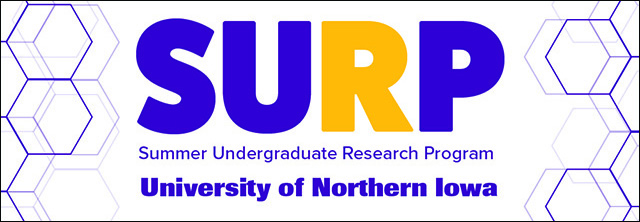
2023 Summer Undergraduate Research Program (SURP) Symposium
Location
ScholarSpace, Rod Library, University of Northern Iowa
Presentation Type
Open Access Poster Presentation
Document Type
poster
Keywords
Cellulose nanocrystals--Additives; Molybdenum disulfide;
Abstract
Cellulose is a substance abundant in nature, found in fruits and vegetables, plant cell walls (National Center for Biotechnology Information, 2023), and wood (Sjostrom, 1993). The abundance of cellulose is attributable to its linear chemical structure, as it is composed of long strands of glucose molecules linked together by hydrogen atoms, which enable the substance to withstand significant pressure without breaking (Rongpipi et al., 2019). This property—known as high tensile strength—is joined by its non-toxicity and sustainability, given cellulose may be degraded and renewed naturally (Kaur, 2021). These various properties indicate versatility, and its resultant current and desired uses—such as in biomedicine concerning wound treatment (Seddiqi et al., 2021) and in the food industry concerning thickening pastes and sauces (Sabbaghi, 2023)—are increased when transformed into nanocellulose, its smaller derivative. In addition to the aforementioned properties, nanocellulose has a low mass per unit volume (or density), and high transparency when purely applied to paper (Hu et al., 2013), and as such, the integration of nanocellulose technology into standard military use has been sought through the development of lightweight tanks and stealth materials, and the magnetization of nanocellulose to become a means for intrinsic communication and weapon detection (Norrrahim et al., 2021). Recent research suggests, however, these applications may be achieved through a combination of nanocellulose and molybdenum disulfide (MoS2), which is a semi-conductive metal with a crystal structure similar to nanocellulose. Thus, from understandings of previous research conducted with nanocellulose and paper, I sought to create a magnetic and low-density form of nanocellulose primarily by adding a 20% (and 15%) concentrated mixture of MoS2 and nanocellulose to coffee filters—which are commonly available and porous—as well as other substrates, such as ground sand. Through this, it was discovered nanocellulose’s natural tendency to break when dry was mitigated when MoS2 served as a substrate; MoS2 did not retain its magnetic properties after drying; the combined form becomes putty-adjacent when subjected to water, and drying temperature and layer amount correlate positively to create a further reinforced form of nanocellulose-MoS2, although of a greater density. Hence, nanocellulose-MoS2 hybrid materials may require additional additives to be utilized in military endeavors.
Start Date
28-7-2023 11:00 AM
End Date
28-7-2023 1:30 PM
Event Host
Summer Undergraduate Research Program, University of Northern Iowa
Faculty Advisor
Timothy E. Kidd
Department
Department of Physics
Copyright
©2023 Mariana Torres, Dylan Seiffert, Elise Hong-Miller, Timothy E. Kidd, Ph.D.
File Format
application/pdf
Recommended Citation
Torres, Mariana; Seiffert, Dylan; Hong-Miller, Elise; and Kidd, T. E., "Molybdenum Disulfide (MoS₂) as a Nanocellulose Substrate" (2023). Summer Undergraduate Research Program (SURP) Symposium. 17.
https://scholarworks.uni.edu/surp/2023/all/17
Molybdenum Disulfide (MoS₂) as a Nanocellulose Substrate
ScholarSpace, Rod Library, University of Northern Iowa
Cellulose is a substance abundant in nature, found in fruits and vegetables, plant cell walls (National Center for Biotechnology Information, 2023), and wood (Sjostrom, 1993). The abundance of cellulose is attributable to its linear chemical structure, as it is composed of long strands of glucose molecules linked together by hydrogen atoms, which enable the substance to withstand significant pressure without breaking (Rongpipi et al., 2019). This property—known as high tensile strength—is joined by its non-toxicity and sustainability, given cellulose may be degraded and renewed naturally (Kaur, 2021). These various properties indicate versatility, and its resultant current and desired uses—such as in biomedicine concerning wound treatment (Seddiqi et al., 2021) and in the food industry concerning thickening pastes and sauces (Sabbaghi, 2023)—are increased when transformed into nanocellulose, its smaller derivative. In addition to the aforementioned properties, nanocellulose has a low mass per unit volume (or density), and high transparency when purely applied to paper (Hu et al., 2013), and as such, the integration of nanocellulose technology into standard military use has been sought through the development of lightweight tanks and stealth materials, and the magnetization of nanocellulose to become a means for intrinsic communication and weapon detection (Norrrahim et al., 2021). Recent research suggests, however, these applications may be achieved through a combination of nanocellulose and molybdenum disulfide (MoS2), which is a semi-conductive metal with a crystal structure similar to nanocellulose. Thus, from understandings of previous research conducted with nanocellulose and paper, I sought to create a magnetic and low-density form of nanocellulose primarily by adding a 20% (and 15%) concentrated mixture of MoS2 and nanocellulose to coffee filters—which are commonly available and porous—as well as other substrates, such as ground sand. Through this, it was discovered nanocellulose’s natural tendency to break when dry was mitigated when MoS2 served as a substrate; MoS2 did not retain its magnetic properties after drying; the combined form becomes putty-adjacent when subjected to water, and drying temperature and layer amount correlate positively to create a further reinforced form of nanocellulose-MoS2, although of a greater density. Hence, nanocellulose-MoS2 hybrid materials may require additional additives to be utilized in military endeavors.



Comments
High school participant in UNI's Summer Undergraduate Research Program (SURP) supported by funding from the AEOP High School Apprentice Program.